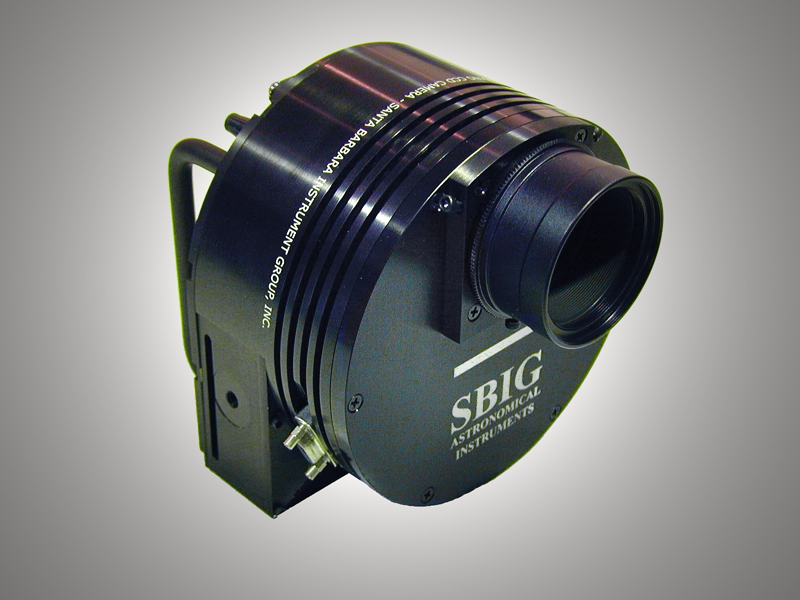Comparison of some key performance specifications of Kodak's
KAI-4020, KAI-4021, and KAI-4022 CCDs
used in SBIG's ST and STL Cameras
We have made cameras with all three versions of Kodak's 4.2 megapixel interline CCD, and the question often arises: What is the difference in each version? According to Kodak's product release for the KAI-4022, this latest version of the 4.2 megapixel interline CCD has lower read noise and fewer bright points than previous versions of the sensor. The QE is the same for the KAI-4020, KAI-4021 and KAI-4022 parts, but according to our initial sampling of about one dozen cameras, the KAI-4022 also appears to have significantly lower average dark current than its predecessors.
1. Pixel size, CCD Size and Fields of View
All three versions of the 4.2 megapixel CCD have the same pixel array configuration: 2048 x 2048 at 7.4 microns. This is a generous sized CCD with twice the area of the CCD used in the ST-2000 and about 60% more area than CCD used in the ST-10XME. The 7.4 micron pixel size is ideal for most amateur telescopes. If we assume that one wants a pixel FOV of about 0.5 to 1.0 arc second per pixel, depending on seeing conditions, then the "optimum" focal lengths for this range can be found in the chart below. As you can see, an unbinned 7.4u pixel has a 1 arc second FOV at a focal length of 1500mm and a 0.5 arc second FOV at 3000 mm. When binned 2x2 (monochrome STL camera) at 14.8 microns this range is extended from 3000 to 6000 mm.
|
|
A word or two about the quest for an ideal focal length: The formula that is often used to arrive at around 2 to 3 pixels per FWHM should only be seen as a guide, not a hard and fast rule. In this case "optimum" simply means that this is the focal length that will yield the best balance of sensitivity and resolution for a wide variety of uses. However, planetary imagers, for instance, often image a much finer resolution and do not worry about loss of sensitivity because planets are rather bright compared to most deep space objects such as diffuse nebula. On the other hand, diffuse nebula tend to be rather large and without as much fine detail as planets and so larger pixels (or shorter focal lengths) than the "optimum" are more easily tolerated. The ideal focal length is often ignored when it comes to wide field imaging, particularly when using camera lenses, and these interline CCDs are preferred for this type of imaging due to their excellent antiblooming properties (See for example: http://www.sbig.com/sbwgifs/4021_M45_mccrady.jpg) The table below shows the CCD field of view for the KAI-4022 and other 4000 series CCDs when used with various focal lengths, including some common camera lenses and short refractors:
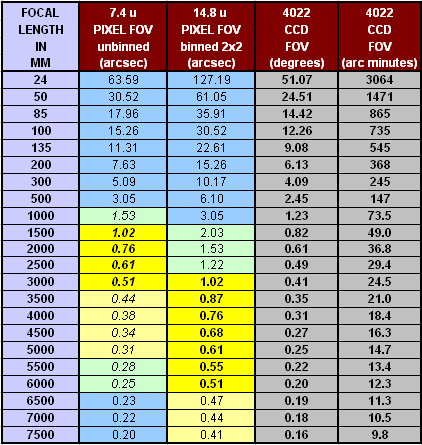 |
2. Quantum Efficiency
Quantum efficiency is sometimes referred to as spectral response because the efficiency of the CCD in converting photons to electrons is highly dependent on the wavelength of light striking the sensor. A sensor that records half of the photons at a given wavelength is said to have a quantum efficiency of 50% at that wavelength. According to Kodak, the QE of the KAI-4020, KAI-4021 and KAI-4022 is the same. The QE curve for the 4000 series CCDs is shown below:
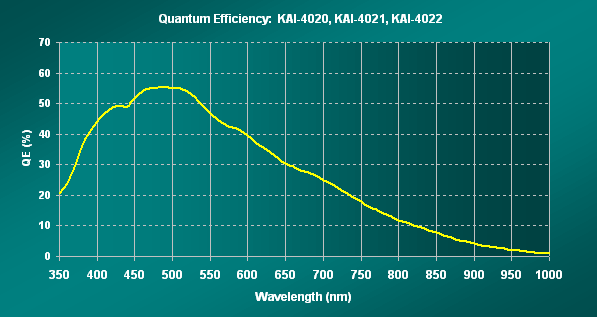 |
The
visible (RGB) portion of the spectrum is from ~400nm to ~700nm.
Kodak's interline CCDs have peak efficiency in the blue and
green making them excellent for recording the weaker blue-green
OIII emission in many nebula. These CCDs are not as strong
at H-alpha (650nm) as the full frame sensors, but the H-alpha
emission line tends to be rather strong compared to the OIII
emission and is still easily recorded with the KAI-4022 and
other interline sensors such as the KAI-11002 used in the
STL-11000 cameras. Click the following link to see some
examples of relatively
short exposures of H-alpha objects taken with a KAI-4021M
CCD installed in a prototype STL camera. There are many fine examples of images
containing H-alpha and OIII emission taken with cameras using
Kodak interline parts to be found on the net, and a visit to our
own Hall of Fame will
reveal some of the best. Insofar as Quantum Efficiency is
concerned, the various versions of the CCD are essentially the
same.
3. Read Noise
Read noise is sometimes called the "noise floor" of the CCD because it is the minimum about of noise you can find in any image from that CCD. It is the noise introduced during the process of reading out the CCD after the exposure is completed, and it does not matter if the exposure is long or short, the read noise is the same. This is one reason that adding together many short exposures is generally not as good as adding together an equivalent total of fewer but longer exposures. The read noise of most modern astronomical CCD cameras is low enough that it is usually not the limiting source of noise in an image, however. For most images, dark current and sky background are the dominant sources of noise. In any event, the Kodak interline have exceptional low read noise characteristics. The read noise specs for our cameras using the KAI-4020, KAI-4021 were already the lowest of any camera that we have made, and now the KAI-4022 has ~25% lower read noise than previous versions!
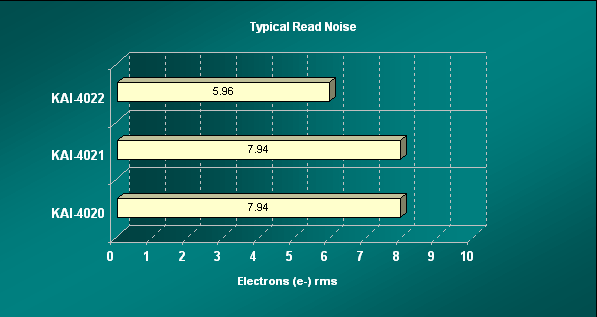 |
The
typical read noise
of the KAI-4020 and KAI-4021 was about the same, ~7.94
electrons. Our measurements of the new KAI-4022 read noise
show it to be about 25% lower on average than the earlier
KAI-4020 and KAI-4021 CCDs. This agrees well with Kodak's specifications for the KAI-4022 CCD
showing a
25% reduction in read noise compared to previous versions of the
sensor.
4. Full Well Capacity
The full well capacity is a measure of how many electrons a pixel can hold before it saturates. Short exposures are dominated by Read Noise, but once your exposures reach a sky background level of about 300 ADU, then the read noise is not a significant factor. 300 ADU is not very much, so Read Noise ceases to be a significant factor after only a very short time, particularly if you use a fast system and/or image near urban skies. However, with a larger Full Well capacity you can ultimately expose an image to higher signal levels without saturation, and thus achieve a higher SNR in the final image. This can be of benefit, for instance, when trying to capture faint detail in the spiral arms of galaxies while at the same time avoiding saturation of the central core.
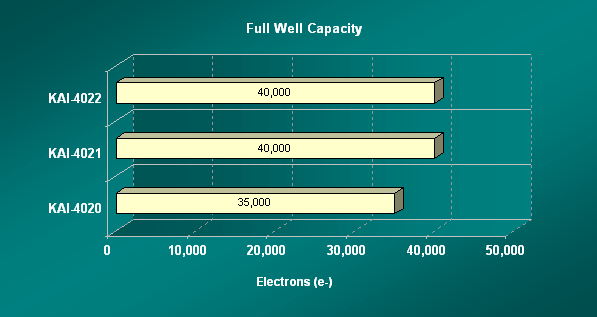 |
We found the full well capacity of the 4020 to be slightly less than the 4021 or 4022. In practice this has little effect, although when combined with the lower read noise of the 4022 it does increase the dynamic range of the sensor by about 50% (see below).
5. Dynamic Range
The dynamic range of a CCD is a measure of its ability to record both faint objects and bright objects in the same image without saturating the bright objects. For our purposes, this can generally be estimated by dividing the full well capacity (ability to record bright objects without saturating) by the read noise (the noise floor or the limit of detection). This results in a ratio that is expressed in electrons, for example 1:5000.
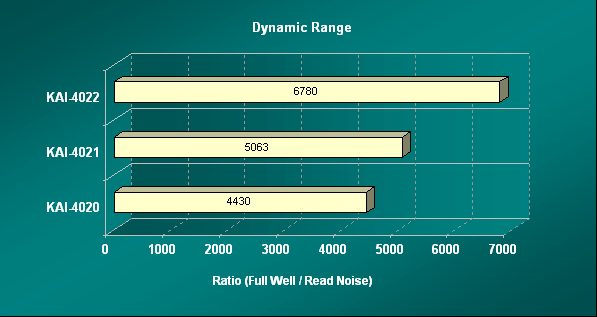 |
As the charts above demonstrate, each version of the 4000 series CCD has improved its dynamic range somewhat. The KAI-4022 has both lower read noise and greater full well capacity than the KAI-4020 and therefore approximately 50% greater dynamic range.
6. Dark Current in the Top 1% of Pixels
Each successive version of this sensor has
shown fewer bright points than the previous version. One test we routinely
perform during production is to measure the dark current in just the top 1%
(brightest) pixels of the array.
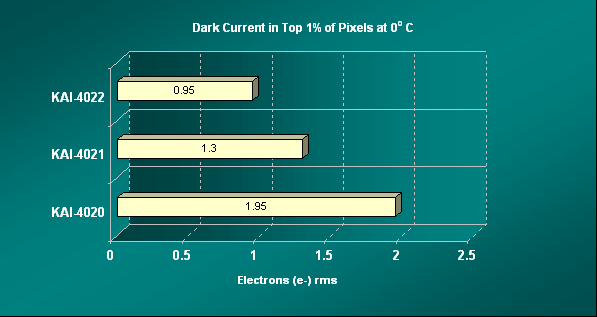 |
As expected, each version of this CCD shows a lower dark current (and therefore lower noise) in the brightest population of pixels. What this means is that not only are there fewer bright points but that the noise contribution caused by these bright points is also lower. Visually, dark frames appear more uniform (see sample dark frames below).
7. Average Dark Current
This is the typical specification for dark current that one sees when comparing CCDs. It is the average (rms) dark current across the entire array. Here again, the interline parts from Kodak already exhibit very low dark current. So the results we have seen with the first few (dozen) cameras containing the KAI-4022 sensor is somewhat unexpected because the Kodak did not change the published specifications for dark current with the release of the KAI-4022. Nevertheless, the new CCDs appear to be significantly better than previous versions of the sensor when it comes to dark current as well.
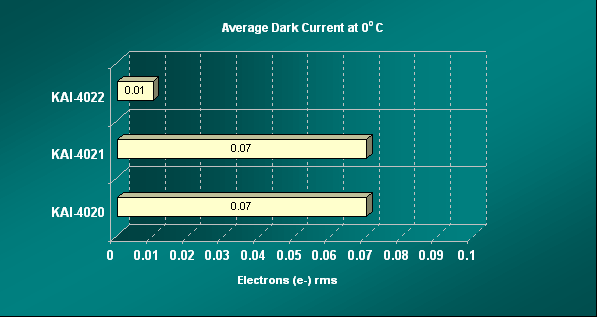 |
Dark current tends to be the greatest source of noise in longer exposures after sky background noise. This balance can be affected by your individual sky conditions, the focal ratio of your optical system, the filters you use, and the ambient temperature. However, with such low dark current specifications, these cameras are quite well suited for just about any condition, even imaging under a dark sky through dark filters with a slow system on a warm night! The dark current of the KAI-4022, for instance at -18 C would be only 0.001 electrons per second. In other words, depending on the actual read noise and dark current of a particular camera, you could take an image of say half an hour or an hour before the dark current equaled the read noise of the camera. If imaging under typical skies found in backyard sites, the sky glow will dominate long before this.
8. Reduction of Bright Points
Bright points are basically pixels that appear brighter than their neighbors in a given exposure. Bright pixels are not necessarily defective pixels, unless they are so bright that they also fit the definition of a defective bright pixel. They may just be brighter "looking" than their neighbor, but still within specs. The can make an image "look" noisy but this is often not a true indication of the amount of noise in the image. Bright points are easily removed with a software filter like the "warm pixel removal" filter in CCDOPS. Of course, the fewer the bright points, the fewer processing steps are needed to remove them, and there is some additional noise associated with brighter pixels, because they have higher dark current than their neighbors. The issue is usually one of cosmetics, however, and here the latest KAI-4022 CCD is quite a bit better than its predecessors. Below are comparison dark frames taken at the same temperature (0 degrees C) and for the same duration (6 minutes) with KAI-4020 and KAI-4022 CCDs. These dark frames clearly demonstrate the reduction in bright points mentioned by Kodak in their new product information about the KAI-4020:
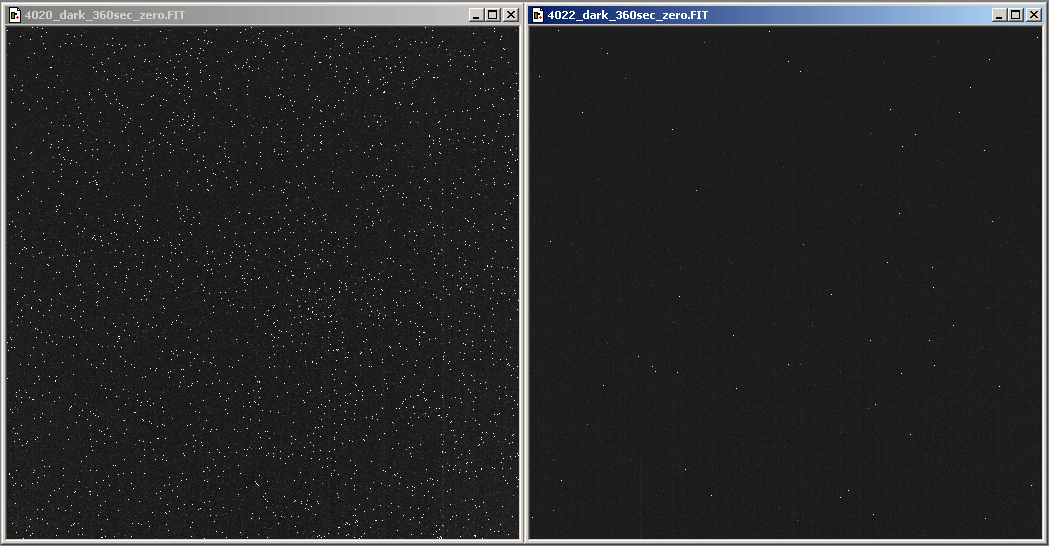 |
|
Comparison of dark
frames from the KAI-4020 and KAI-4022 CCDs. Both are 360
second darks taken at zero degrees and reduced 4X for display. |
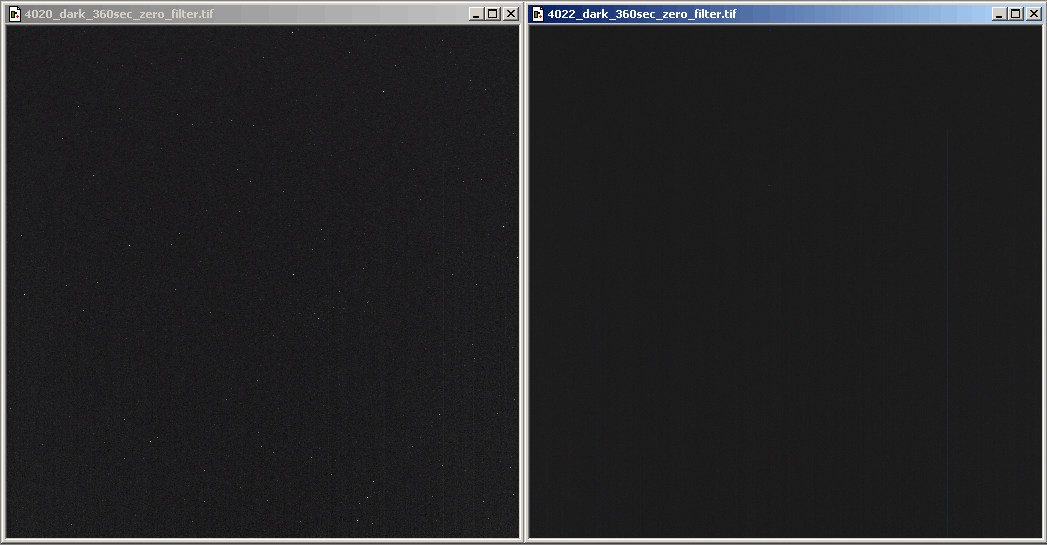 |
|
This is the
same pair of 360 second dark frames as above, but displayed
after a (medium) warm pixel removal |
